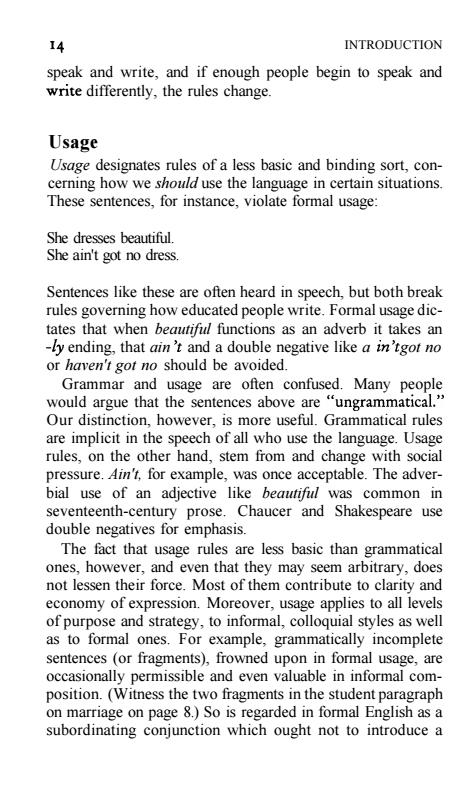正在加载图片...

14 INTRODUCTION speak and write,and if enough people begin to speak and write differently,the rules change. Usage Usage designates rules of a less basic and binding sort,con- cerning how we should use the language in certain situations. These sentences,for instance,violate formal usage: She dresses beautiful. She ain't got no dress. Sentences like these are often heard in speech,but both break rules governing how educated people write.Formal usage dic- tates that when beautiful functions as an adverb it takes an -ly ending,that ain't and a double negative like a in'tgot no or haven't got no should be avoided. Grammar and usage are often confused.Many people would argue that the sentences above are "ungrammatical." Our distinction,however,is more useful.Grammatical rules are implicit in the speech of all who use the language.Usage rules,on the other hand,stem from and change with social pressure.Ain't,for example,was once acceptable.The adver- bial use of an adjective like beautiful was common in seventeenth-century prose.Chaucer and Shakespeare use double negatives for emphasis. The fact that usage rules are less basic than grammatical ones,however,and even that they may seem arbitrary,does not lessen their force.Most of them contribute to clarity and economy of expression.Moreover,usage applies to all levels of purpose and strategy,to informal,colloquial styles as well as to formal ones.For example,grammatically incomplete sentences (or fragments),frowned upon in formal usage,are occasionally permissible and even valuable in informal com- position.(Witness the two fragments in the student paragraph on marriage on page 8.)So is regarded in formal English as a subordinating conjunction which ought not to introduce a14 INTRODUCTION speak and write, and if enough people begin to speak and write differently, the rules change. Usage Usage designates rules of a less basic and binding sort, concerning how we should use the language in certain situations. These sentences, for instance, violate formal usage: She dresses beautiful. She ain't got no dress. Sentences like these are often heard in speech, but both break rules governing how educated people write. Formal usage dictates that when beautiful functions as an adverb it takes an -ly ending, that ain yt and a double negative like a in't got no or haven't got no should be avoided. Grammar and usage are often confused. Many people would argue that the sentences above are "ungrammatical." Our distinction, however, is more useful. Grammatical rules are implicit in the speech of all who use the language. Usage rules, on the other hand, stem from and change with social pressure. Ain't, for example, was once acceptable. The adverbial use of an adjective like beautiful was common in seventeenth-century prose. Chaucer and Shakespeare use double negatives for emphasis. The fact that usage rules are less basic than grammatical ones, however, and even that they may seem arbitrary, does not lessen their force. Most of them contribute to clarity and economy of expression. Moreover, usage applies to all levels of purpose and strategy, to informal, colloquial styles as well as to formal ones. For example, grammatically incomplete sentences (or fragments), frowned upon in formal usage, are occasionally permissible and even valuable in informal composition. (Witness the two fragments in the student paragraph on marriage on page 8.) So is regarded in formal English as a subordinating conjunction which ought not to introduce a